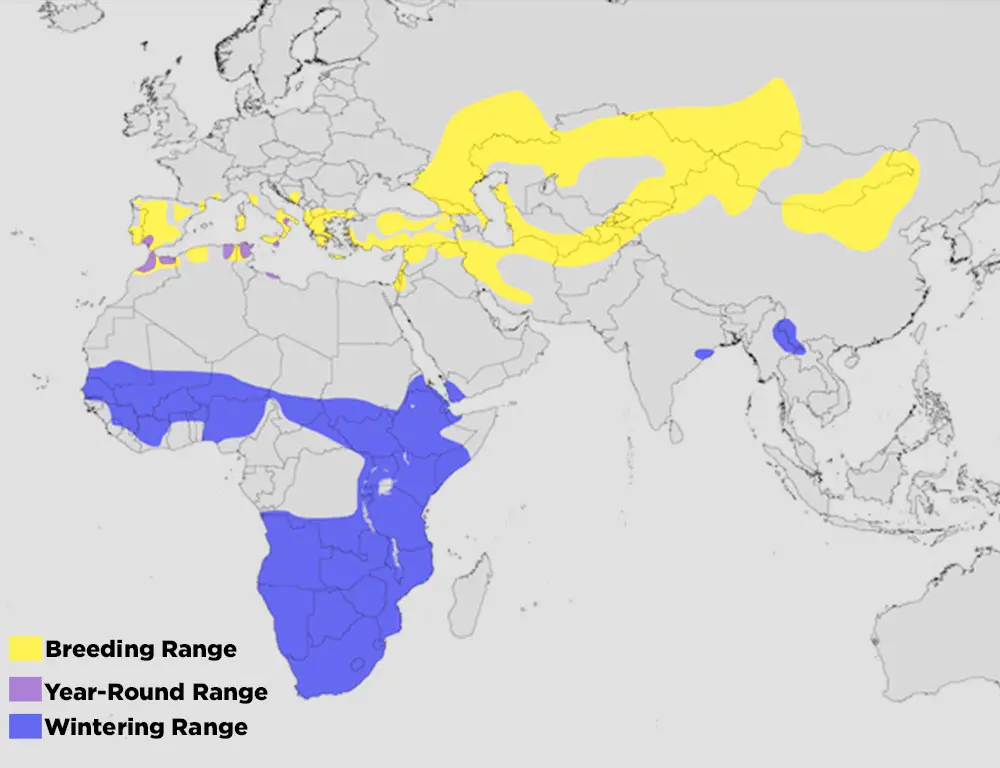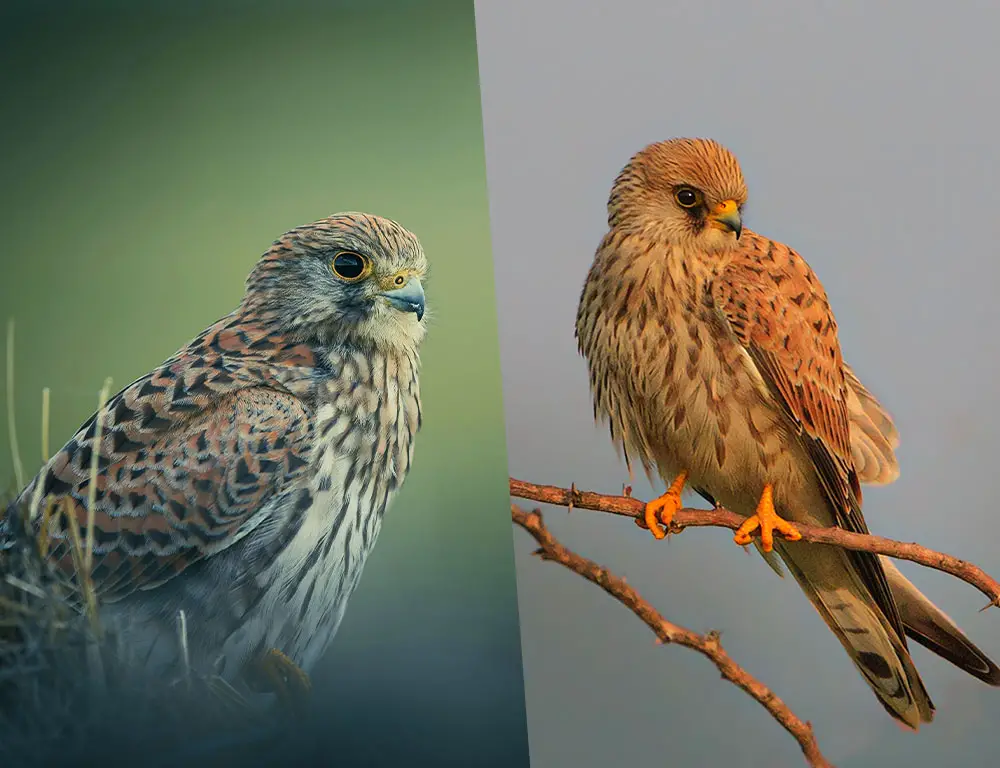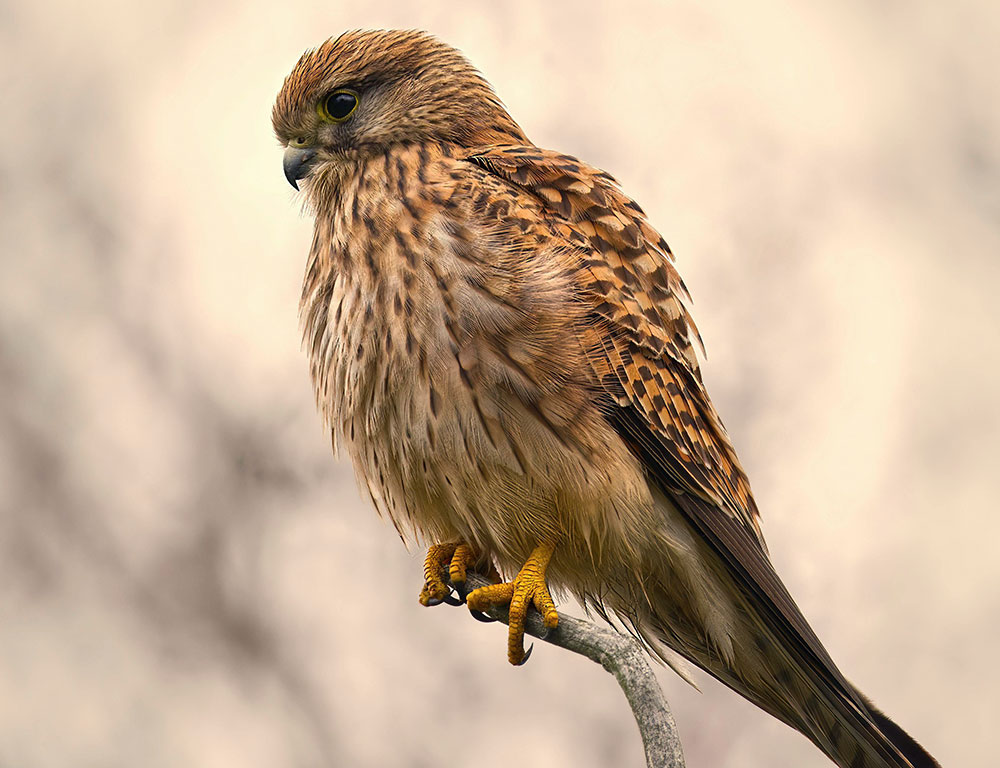The Lesser Kestrel (Falco naumanni) is a small but charismatic bird of prey belonging to the Falconidae family. With its distinctive appearance characterized by slate-blue upperparts, buff underparts, and striking facial markings, this species captivates bird enthusiasts and researchers alike.
Found primarily in Europe, North Africa, and parts of Asia, the Lesser Kestrel prefers open habitats such as grasslands, steppes, and agricultural fields where it hunts for small vertebrates and insects.
Despite facing threats like habitat loss, pesticide use, and decline in insect populations, conservation efforts have been pivotal in stabilizing its populations.
This species exhibits fascinating social behaviors, often forming colonies on cliffs, buildings, or other elevated structures during breeding season.
Its adaptability to urban environments has led to its coexistence with humans, providing opportunities for observation and study.

Characteristics Of Lesser Kestrel
The Lesser Kestrel (Falco naumanni) is a fascinating bird of prey known for its unique characteristics and behaviors.
Here are some common characteristics of this avian species:
Physical Characteristics
The Lesser Kestrel (Falco naumanni) is a small but charismatic bird of prey known for its graceful flight and striking appearance.
Here are seven key physical characteristics that distinguish this avian species:
Size
The Lesser Kestrel (Falco naumanni) is a diminutive bird of prey, measuring between 27 to 33 centimeters (11 to 13 inches) in length, with a wingspan ranging from 63 to 72 centimeters (25 to 28 inches).
Although resembling the Common Kestrel, it distinguishes itself with shorter wings and tail, maintaining a compact stature.
Plumage
Adult male Lesser Kestrels display a distinctive combination of slate-gray upperparts and reddish-brown underparts, with prominent black barring on the wings and tail. Females and juveniles have similar plumage but with less contrast and barring.
Facial markings
Lesser Kestrels have a striking facial pattern, including a black mask-like stripe across the eyes and a whitish throat patch. These facial markings help distinguish them from other falcon species in flight.
Wings
The Lesser Kestrel’s wings are long and pointed, with a wingspan of approximately 58-72 centimeters. This wing shape enables rapid and agile flight, allowing the bird to maneuver effortlessly in pursuit of prey.
Tail
The Lesser Kestrel (Falco naumanni) possesses a distinctive tail characterized by its long, bluntly-pointed shape. It features a dark subterminal band and slightly elongated central tail feathers, distinguishing it from other kestrel species.
This unique tail morphology aids in precise maneuverability during flight, particularly during hunting and aerial displays.
Beak and Talons
Like all birds of prey, Lesser Kestrels have a hooked beak and sharp talons adapted for capturing and dispatching prey. Their beak is dark gray or black, while their talons are strong and well-suited for grasping small vertebrates and insects.
Sexual dimorphism
Male and female Lesser Kestrels exhibit slight differences in size and plumage coloration, with males typically being smaller and more brightly colored than females.
This sexual dimorphism is most pronounced during the breeding season when males engage in courtship displays to attract mates.
Distribution And Habitat
The Lesser Kestrel (Falco naumanni) inhabits a diverse range of habitats across Europe, North Africa, and parts of Asia. It favors open landscapes including grasslands, steppes, agricultural fields, and urban areas.
This adaptable bird of prey forms colonies on cliffs, buildings, and other elevated structures during the breeding season. Its distribution reflects its ability to thrive in both natural and human-altered environments.
Behavior And Ecology
These kestrels are agile hunters, specializing in capturing small vertebrates and insects on the wing. They often hunt cooperatively in small groups, using their keen eyesight and aerial acrobatics to pursue prey precisely.
Cultural Depiction
In various cultures, Lesser Kestrels have been depicted in art, folklore, and literature as symbols of speed, agility, and freedom. Their graceful flight and hunting prowess have inspired admiration and respect throughout history.
Conservation Status
While once widespread, Lesser Kestrel populations have declined due to habitat loss, agricultural intensification, and pesticide use. As a result, they are classified as Near Threatened on the IUCN Red List, highlighting the need for conservation efforts to protect their breeding and wintering habitats, as well as mitigate threats to their survival.
Overall, the Lesser Kestrel’s distribution, behavior, ecological importance, cultural significance, and conservation status underscore its unique role in the natural world and the importance of preserving its populations for future generations.
Taxonomy
Here’s the taxonomy table for the Lesser Kestrel (Falco naumanni):
| Taxonomy Level | Classification |
| Kingdom | Animalia |
| Phylum | Chordata |
| Class | Aves |
| Order | Falconiformes |
| Family | Falconidae |
| Genus | Falco |
| Species | Falco naumanni |
Nesting Habit Of Lesser Kestrel
Here’s a table outlining the nesting habits of the Lesser Kestrel:
| Nesting Habit | Description |
| Nest Location | Typically builds nests in colonies on cliffs, rocky outcrops, buildings, or other elevated structures. |
| Nest Materials | It was constructed primarily from twigs, grass, and feathers, lined with softer materials such as wool or fur. |
| Nest Construction | Both males and females participate in nest-building, with the female usually taking the lead in arranging and shaping. |
| Breeding Season | Breeds during the warmer months, with nesting activity peaking in spring and early summer. |
| Egg Laying | The female lays a clutch of 3-6 eggs, which both parents incubate for around 28-32 days. |
| Chick Rearing | Both parents participate in feeding and caring for the chicks, which fledge after about 4-5 weeks from hatching. |
| Nesting Success | Success rates vary depending on factors such as predation, weather conditions, and availability of food resources. |
Description of the Ranging Map Of Lesser Kestrel

The ranging map of the Lesser Kestrel (Falco naumanni) visualizes the species’ distribution across its breeding and wintering habitats. This map illustrates where Lesser Kestrels are commonly found, offering insights into their migratory patterns and geographical range.
Typically, the ranging map depicts breeding populations of Lesser Kestrels in Europe, Asia, and parts of Africa, highlighting regions where they nest and raise their young during the summer months.
These breeding habitats often include open grasslands, agricultural fields, and steppes, where suitable nesting sites such as cliffs, buildings, and nest boxes are available.
During the winter months, the ranging map may also show the migration routes and wintering grounds of Lesser Kestrels as they move to warmer climates in Africa and Asia to escape harsh winter conditions in their breeding areas.
Coastal regions, marshes, and wetlands are typical wintering habitats for Lesser Kestrels, where they can find ample food resources and favorable roosting sites.
What Is The Difference Between A Kestrel And A Lesser Kestrel?

Kestrels and Lesser Kestrels are both members of the falcon family (Falconidae) and share many similarities, but they have several key differences. Here are seven distinctions:
Size
Kestrels, specifically the Common Kestrel (Falco tinnunculus), are more significant than Lesser Kestrels (Falco naumanni), with adults typically measuring around 32-39 centimeters in length, compared to the Lesser Kestrel’s more petite size of 27-33 centimeters.
Plumage
Common Kestrels exhibit a more comprehensive range of plumage variations, with males displaying a combination of reddish-brown upperparts and slate-blue wings. At the same time, females and juveniles have more muted colors with brown streaking.
In contrast, Lesser Kestrels have distinctive slate-gray upperparts and reddish-brown underparts, with prominent black barring on the wings and tail in both sexes.
Habitat
Common Kestrels are versatile birds found in various habitats, including open countryside, farmland, and urban areas, where they hunt for small mammals and birds from perches or while hovering.
Lesser Kestrels prefer more open habitats, such as grasslands, steppes, and agricultural areas, where they primarily feed on insects and small vertebrates captured in flight.
Range
Common Kestrels have a more comprehensive global distribution, occurring throughout Europe, Asia, and parts of Africa, as well as in North America under the name American Kestrel (Falco sparverius).
On the other hand, Lesser Kestrels have a more restricted range, breeding in Europe, Asia, and Africa, with some populations migrating to wintering grounds in warmer regions.
Conservation Status
While both species face threats from habitat loss, pesticide use, and other human-induced pressures, the conservation status of Common Kestrels is generally of Least Concern, with stable populations in many regions.
In contrast, Lesser Kestrels are classified as Near Threatened on the IUCN Red List, indicating declining populations and a higher risk of extinction.
Migratory Behavior
Common Kestrels are generally non-migratory or undertake short-distance migrations in response to changing weather and food availability.
Lesser Kestrels, however, are migratory birds, with populations in Europe and Asia migrating to wintering grounds in Africa during the colder months.
Voice
Common Kestrels are known for their distinctive kee-kee-kee call, often heard during courtship displays or while defending territory.
Lesser Kestrels have a softer and less conspicuous vocalization, with short, high-pitched chirps and trills used for communication among individuals.
While Kestrels and Lesser Kestrels share many characteristics as members of the falcon family, they differ in size, plumage, habitat preferences, range, conservation status, migratory behavior, and vocalizations.
These differences reflect their unique adaptations to different environments and ecological niches across their respective ranges.
What Is The Lesser Kestrel Famous For?

The Lesser Kestrel (Falco naumanni) is celebrated for its unique characteristics and behaviors, earning it recognition and admiration among birdwatchers and conservationists.
Here are seven things the Lesser Kestrel is famous for:
Small Size
The Lesser Kestrel is renowned for being one of the smallest members of the falcon family, measuring around 27-33 centimeters in length. Its diminutive size and agile flight make it a fascinating subject of study and observation.
Graceful Flight
These kestrels are famous for their graceful flight, characterized by rapid wing beats and agile maneuvers. They are adept at hovering, soaring, and diving in pursuit of prey, showcasing their aerial prowess and hunting skills.
Distinctive Plumage
The Lesser Kestrel is known for its striking plumage, featuring slate-gray upperparts, reddish-brown underparts, and prominent black barring on the wings and tail.
Its colorful appearance adds to its allure and makes it easily recognizable in the field.
Colonial Nesting
Lesser Kestrels are famous for their colonial nesting habits, often breeding in large colonies near one another. They utilize a variety of nesting sites, including cliffs, buildings, and nest boxes, where they raise their young communally.
Agile Hunters
These kestrels are renowned for their agility and hunting prowess. They specialize in capturing small vertebrates and insects on the wing, using their keen eyesight and aerial acrobatics to pursue prey precisely.
Migration
Lesser Kestrels are famous for their long-distance migrations, traveling thousands of kilometers between their breeding and wintering grounds. They undertake arduous journeys across continents, relying on favorable winds and weather conditions to complete their annual migrations.
Conservation Efforts
The Lesser Kestrel is famous for being the focus of conservation efforts to protect its populations and habitats. Conservation initiatives include habitat restoration, captive breeding programs, and breeding colony monitoring to ensure long-term survival.
Overall, the Lesser Kestrel’s small size, graceful flight, distinctive plumage, colonial nesting habits, agile hunting skills, migratory behavior, and conservation significance contribute to its fame and popularity as a beloved and iconic bird species.
Conclusion
The Lesser Kestrel (Falco naumanni) emerges as a captivating species, characterized by its small stature, unique tail morphology, and adaptable nature. Despite resembling its larger counterpart, the Common Kestrel, it stands out with proportionally shorter wings and tail, aiding in precise flight maneuvers.
The distribution of the Lesser Kestrel across Europe, North Africa, and parts of Asia highlights its resilience and ability to thrive in various habitats, from open grasslands to urban environments.
However, this charismatic bird of prey faces threats such as habitat loss and declines in insect populations, necessitating concerted conservation efforts. Understanding its ecology and behavior is vital for ensuring the continued presence of the Lesser Kestrel in ecosystems worldwide.
Through conservation initiatives and public awareness, we can work towards safeguarding this species and preserving the invaluable role it plays in maintaining ecological balance.
